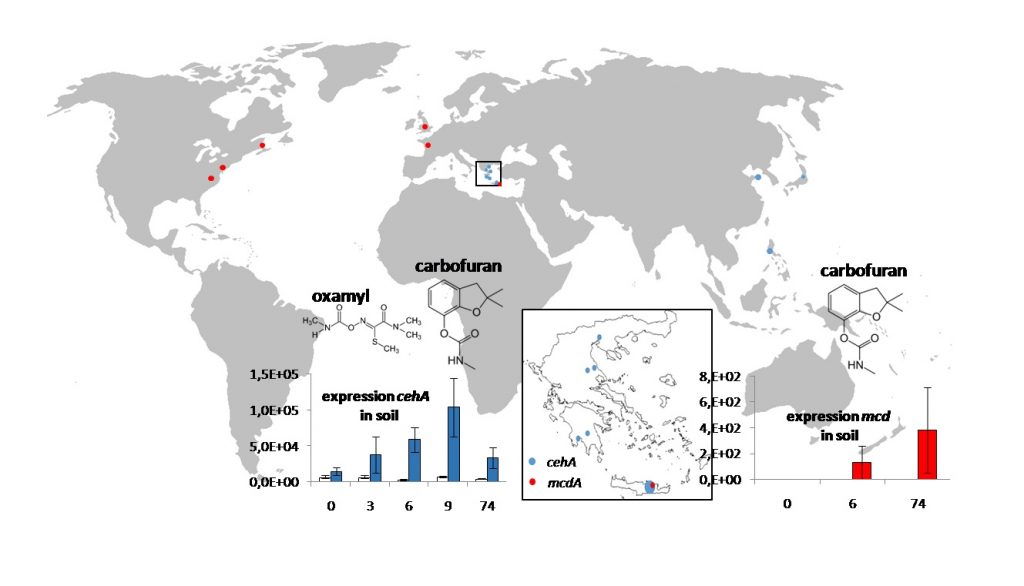Microbial degradation constitutes the main process controlling the environmental dissipation of organophosphate and carbamate soil insecticides/nematicides. Paradoxically, microbial degradation, which was initially viewed as a desirable process for reducing environmental hazards, has turned into a double-edged sword with the development of the phenomenon of enhanced microbial degradation. Repeated application of the same pesticide onto the same field site for a number of years could result in microbial adaptation and could lead to rapid pesticide dissipation due to microbial degradation. This phenomenon was called enhanced microbial degradation and could lead to loss of biological efficacy of the pesticide. Our research focus is on soils exhibiting enhanced biodegradation of soil nematicides in order:
(i) to isolate bacteria able to hydrolyze these compounds, identify key genes involved in the hydrolysis of these compounds and obtain the esterases encoded by these enzymes via heterologous expression
(ii) to study the evolution, ecology and distribution in soil of genes (i.e. cehA) involved in the hydrolysis of carbamates or organophosphates.

Funding
- Research Activities supported by the Research Committee of the University of Thessaly, Isolation and characterization of fenamiphos and oxamyl – degrading bacteria. Funding: Research Committee of the University of Thessaly, Duration: 1/10/2009-30/9/2011
- Industrial Project, A survey of the degradation of the soil insecticides in potato cultivation areas in Greece. Duration: 1/7/2013-31/5/2014
Publications
- Karpouzas, D.G., Walker, A., Froud-Williams, R.J., and Drennan D.S.H. (1999) Evidence for the enhanced biodegradation of ethoprophos and carbofuran in soils from Greece and the UK. Pesticide Science 55: 301-311
- Karpouzas, D.G., Giannakou, I.O., Walker, A., and Gowen, S.R. (1999). Reduction in biological efficacy of ethoprophos in a soil from Greece due to enhanced biodegradation: comparing bioassay with laboratory incubation data. Pesticide Science 55: 1089-1094
- Karpouzas, D.G., and Walker, A. (2000). Factors influencing the ability of Pseudomonas putida strains epI and II to degrade the organophosphate ethoprophos. Journal of Applied Microbiology 89: 40-48
- Karpouzas, D.G., and Walker, A. (2000). Factors influencing the ability of Pseudomonas putida epI to degrade ethoprophos in soil. Soil Biology & Biochemistry 32: 1753-1762
- Karpouzas, D.G., Morgan, J.A.W., and Walker, A. (2000). Isolation and characterisation of ethoprophos-degrading bacteria. FEMS Microbiology Ecology 33: 209-218
- Karpouzas, D.G., Morgan, J.A.W., and Walker, A. (2000). Isolation and characterization of 23 carbofuran-degrading bacteria from soils from distant geographical areas. Letters in Applied Microbiology 31: 353-358
- Karpouzas, D.G., and Walker, A. (2000). Aspects of the enhanced biodegradation and metabolism of ethoprophos in soil. Pest Management Science 56 : 540-548
- Karpouzas, D.G., Walker, A., Drennan, D.S.H., Froud-Williams, R.J. (2001). The effect of initial concentration of carbofuran on the development and stability of its enhanced biodegradation in top-soil and sub-soil. Pest Management Science 57: 72-81
- Karpouzas, D.G., and Giannakou, I.O. (2002). Biodegradation and Εnhanced Βiodegradation: A Reason for Reduced Biological Efficacy of Nematicides. Russian Journal of Nematology 10: 59-78
- Karpouzas, D.G., Hatziapostolou, P., Papadopoulou-Mourkidou, E., Georgiadou, A., and Giannakou I.O., (2004). The enhanced biodegradation of fenamiphos in soils from previously-treated field sites in Greece and the effect of soil fumigants on the development of the phenomenon. Environmental Toxicology & Chemistry 23: 2099-2107.
- Κarpouzas, D.G., Karanasios, E., Menkissoglou-Spiroudi, U., (2004). Enhanced microbial degradation of cadusafos in soils from potato monoculture: Demonstration and characterization, Chemosphere 56: 549-559
- Κarpouzas, D.G., Karanasios, E., Giannakou I.O., Georgiadou, A., and Menkissoglou-Spiroudi, U., (2004) The effect of soil fumigants methyl bromide and metham sodium on the microbial degradation of the nematicide cadusafos. Soil Biology & Biochemistry 37: 541-550.
- Giannakou, I.O., Karpouzas, D.G., Anastasiades, I., Tsiropoulos, N.G., and Georgiadou, A., (2005). Factors affecting the efficacy of non-fumigant nematicides for the control of root-knot nematodes. Pest Management Science 61 (10), 961-972.
- Karpouzas, D.G., Fotopoulou, A., U. Menkissoglu-Spiroudi, Singh, B.K. (2005). Non-specific biodegradation of the organophosphorus pesticides, cadusafos and ethoprophos, by two bacterial isolates. FEMS Microbiology Ecology 53: 369-378.
- Karpouzas, D.G. and Singh, B.K. (2006) Phosphorus containing xenobiotics: microbial degradation, metabolic pathways and molecular basis. Advances in Microbial Physiology 51: 119-186.
- Chanika E., Soueref E., Georgiadou D, Karas P., Karanasios E., Tsiropoulos N., Tzortzakakis E., Karpouzas D.G., (2011) Isolation of soil bacteria able to hydrolyze both organophosphate and carbamate pesticides. Bioresource Technology 102 (3): 3184-3192
- Papadopoulou E.S, Lagos S., Spentza F., Vidiadakis E., Karas P.A, Klitsinaris T., Karpouzas D.G. (2016) The dissipation of fipronil, chlorpyrifos, fosthiazate and ethoprophos in soils from potato monoculture areas: first evidence for the development of enhanced biodegradation of fosthiazate. Pest Management Science 72(5): 1040-1050
- Rousidou C., Chanika E., Georgiadou D., Soueref E., Katsarou D., Kolovos P., Ntougias S., Tourna M., Tzortzakakis E.A., Karpouzas D.G., (2016) Isolation of oxamyl-degrading bacteria and identification of cehA as a novel oxamyl hydrolase gene. Frontiers in Microbiology 7: 616 (doi:10.3389/fmicb.2016. 00616)
- Rousidou C., Karaiskos D., Myti D., Karanasios E., Karas P.A., Tourna M., Tzortzakakis E.A., Karpouzas D.G. (2017) Distribution and function of carbamate hydrolase genes cehA and mcd in soils: the distinct role of soil pH. FEMS Microbiology Ecology 93(1): fiw219 doi:10.1093/femsec/fiw219
- Lagos E., Perruchon C., Katsoula A., Karpouzas D.G., (2019) The isolation and characterization of soil bacteria able to rapidly degrade the organophosphorus nematicide fosthiazate. Letters in Applied Microbiology 68: 149-155
Personnel
- Konstantina Rousidou, PhD student